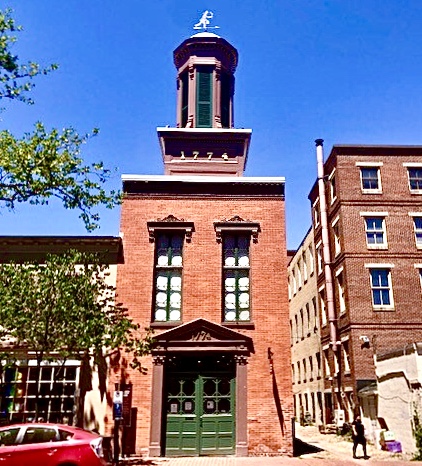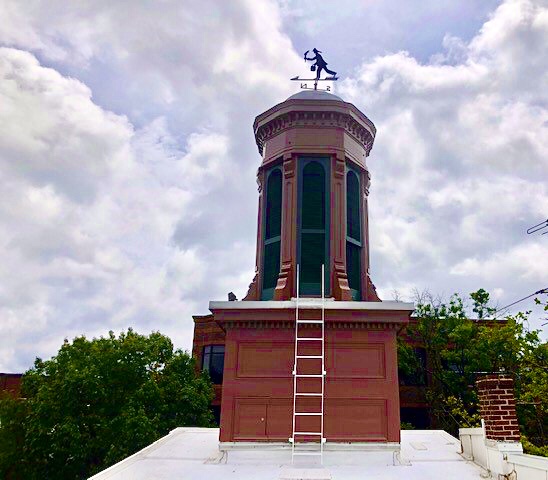Rattles, Horns, Triangles, and Bells: Learn the Sounds of Fire Safety™!

By Jim Holloway, The Lyceum
Alexandria, VA – What are the many sounds of fire safety? Each year, during the week of October 9, the National Fire Prevention Association (NFPA) sponsors Fire Prevention Week, the nation’s longest-running public health observance. The City of Alexandria’s Friendship Firehouse Museum, built in 1855, will be open Saturday, October 9, from 11 am – 5 pm to culminate the week.
The theme of this year’s Fire Prevention Week is “Learn the Sounds of Fire Safety™,” which, as the NFPA website says, “puts the focus on educating children and adults about smoke and carbon monoxide (CO) alarms, their necessity, and how the sounds they make help save lives.”
The sounds of fire safety were different before smoke and carbon monoxide alarms were available in the 19th century. Police officers were often the first to spot fires. They used loud rattles and other noisemakers to sound the alarm and alert the citizens and the fire companies.
On October 10, 1871, in the immediate aftermath of the Great Chicago Fire that later inspired Fire Prevention Week, the Alexandria Gazette wrote, “Mr. Wheat, at the request of the Chief Engineer of the Fire Department, offered a resolution [to City Council] that the Mayor be authorized to purchase twenty-one tin horns to be sounded by the police during fires at night.” He added that the city currently alerted people using the Hook and Ladder Company’s bell and triangle.

A council member asked for reassurance that the horns would only be used at night, to which Mr. Wheat replied, “Certainly; people are not supposed to be asleep in the daytime.” City Council authorized the purchase. But while rattles, horns, and triangles were useful, bells were most effective in sending out the alarm and calling the firefighters to their stations.
The Friendship Fire Company owned three bells during its long history. They purchased the first in 1839 when their firehouse was located on King Street between Columbus and Alfred Streets. The Company “ordered that the bell be rung upon every alarm of fire and toll when necessary to notify members of meeting.” As the company grew and obtained more equipment, it changed that by-law to read, “The Bell shall be tolled preparatory to each meeting and rung when there is a fire indicating by distinct strokes the ward in which it occurred.” How they rang the bell communicated where the fire was located. They also rang it when their fire-fighting apparatus returned from an alarm.
The 1839 bell underwent extensive repairs over the years. In 1855, it was replaced with a new bell installed in their new firehouse on Alfred Street. This second bell did not last long. Company member John Muir noted that it was damaged while saluting a visiting fire company in 1856, the year after they purchased it. It may also have been damaged when lightning struck the firehouse steeple in August 1856. (The company later changed the steeple to the smaller cupola seen on Friendship Firehouse today.)
The company purchased its third and final bell from Regester & Webb in Baltimore, Maryland, in 1857. On March 24, 1857, the Alexandria Gazette described the new bell as “weighing about 600 lbs., and costing, with its fixtures, almost $300 … and is represented to be of excellent tone. Key of D.” The article notes that the old bell was removed from the steeple and thrown from the roof to the ground “without any increased injury thereto.”
There are different ways to ring a bell mounted in a steeple or tower. The bell can be fixed in a static position, called “hung dead,” and hit with a hammer or rung with a rope that pulls an internal clapper. Or there are ways to swing a bell to make it ring.

In the case of Friendship’s bell, its top was affixed to a yoke that was attached to a wheel. Pulling ropes from the ground level rotated the wheel, making the bell swing back and forth, and the clapper rang the bell. Eventually, however, workers attached the bell to a wooden frame to secure and preserve it. The bell no longer swings, but with a rope attached to the clapper, it can be rung on special occasions. If you visit Friendship Firehouse on October 9, perhaps you’ll hear the bell ring, with its “excellent tone. Key of D.” For more information on Fire Prevention Week, visit nfpa.org. Timed arrival tickets to visit Friendship Firehouse Museum on October 9 can be purchased at AlexandriaVA.gov/Shop.
ICYMI: The Friendship Firehouse Festival Is Back!




